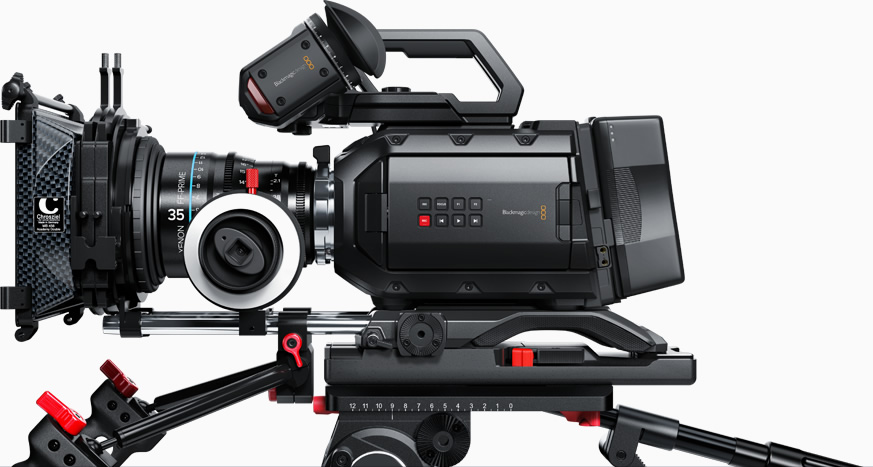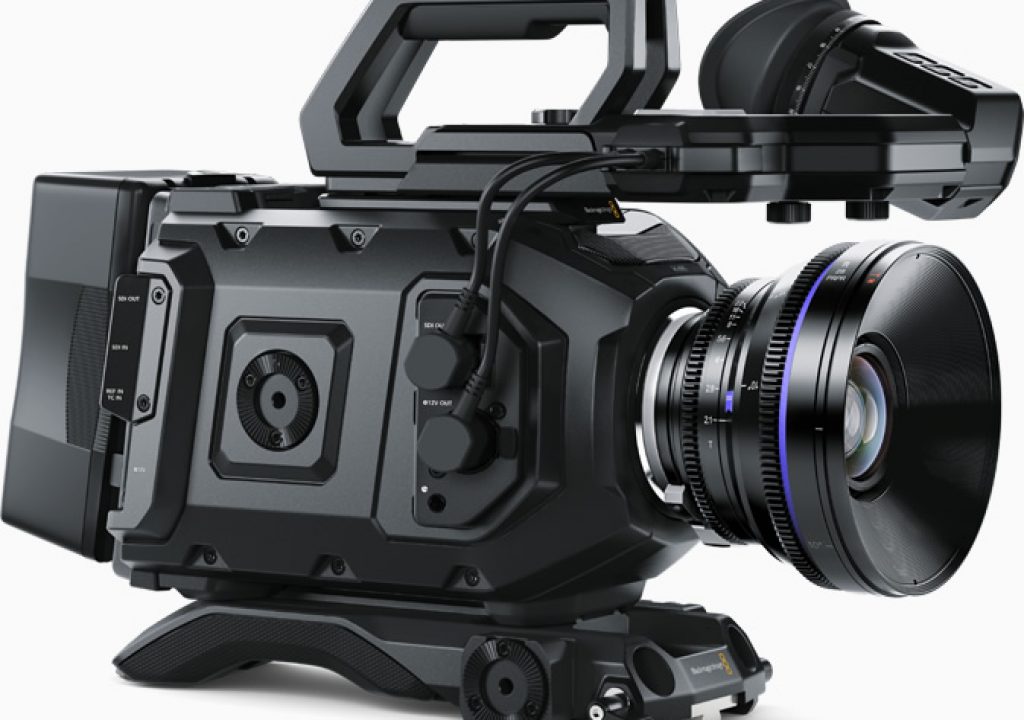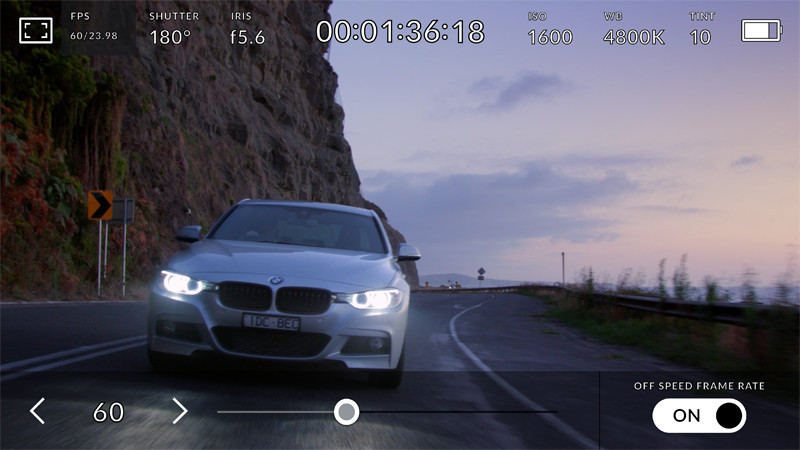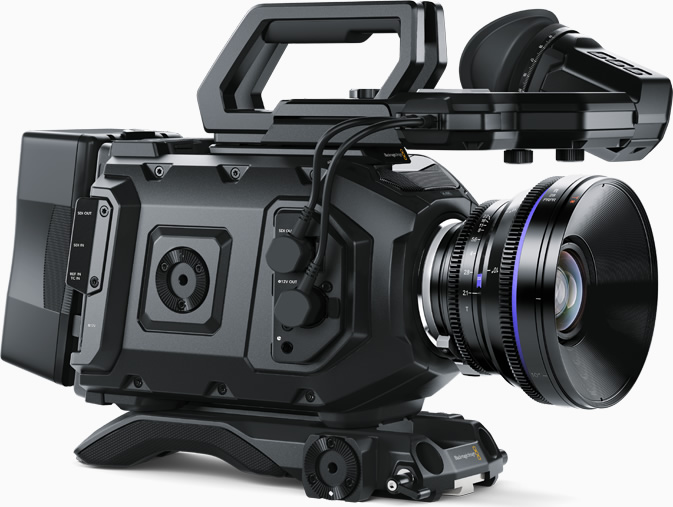Overnight Blackmagic Design released the new user interface and operation system for the URSA Mini out of Beta. Firmware 4.0 is official. Funny thing is the 4.0 Beta and 4.0 Beta 2 of the URSA Mini firmware worked so well I barely saw anything wrong or needing another look. Blackmagic Design says firmware 4.0 is the “other half” of the URSA Mini. I have both the 4.6K and 4K URSA Mini on hand and I can attest to their statement. The new UI / OS definitely helps to elevate the overall shooting experience with these cameras. If you have not updated or tested the Beta UI/OS, I would do so as soon as possible.
Interestingly, the new operating system in which each camera feature runs as a separate app. This gives you great stability and means Blackmagic will be able to add new features down the line. The great thing is, this firmware works for both URSA Mini cameras: the 4.6K and the 4K, however, some of the features will only appear in the 4.6K URSA Mini. For example, only the 4.6K URSA Mini allows 3K Anamorphic shooting.
The Highlights
Both the 4.6L and 4K URSA Mini gain a much friendlier heads up display. You can see an example above. This update allows a shooter to access key settings straight from the LCD monitor instead of diving through the menu. This also means one can change White Balance, Iris, FPS, Shutter, Audio Levels, and ISO setting right from the LCD screen. When shooting this way the URSA Mini becomes very easy to operate. Yet, hand-held shooting allows some setting changes too.
Function Buttons
Blackmagic has enabled to F1 and F2 buttons to be assigned. You can trigger presets, turn on / off features with the buttons, or you can cycle through setting by repeatedly tapping the button to find the right settings. You can turn Off-Speed Shooting on / off. You can cycle through project FPS. One of my favorites is the ability to cycle through the ISO Settings. This is the first time we have this option as an outside button and not a menu dive. Other settings which can be changed from the function buttons are: shutter, ISO, White balance, FPS, Off-speed shooting, and more.
Added Raw/ProRes Flavors
Shooting raw is one of the big benefits of the URSA Mini 4.6K or 4K. Now, one can now shoot raw at 4.6K, 4.6K 2.4:1, 4K 16:9, 4K DCI, Ultra HD, 3K Anamorphic, 2K 16:9, 2K DCI, and HD. This gives shooters many options for their raw recording. When shooting ProRes Blackmagic gives you the same options as raw when it comes to resolution. This gives you the option to shoot 4.6K raw, ProRes XQ, 444, HQ, ProRes, LT, and Proxy. All at 4.6K resolution. This, of course, goes for all the resolution sizes. We also get three different raw recording options: Raw, 3:1 and 4:1. For card space, I typically shoot 4:1 or 3:1.
LUTS
Originally, I did not think I would use the import LUTs feature, but I have turned to it more than expected. This is how it works. You can export, or create and then export, a 3D LUT from DaVinci Resolve and you save it to your CFast 2.0 cards. You put the card with the LUT on it into your 4.6K URSA Mini and you import it. This gives you the option to use this newly imported 3D LUT for your monitoring on you LCD or EVF. One can even use the LUT on the SDI out on the 4.6K URSA Mini.
For users updating from 4.0 Beta or 4.0 Beta 2, it is advisable to export your presets and LUT’s onto a card as they will be removed during this update.
What’s new in Blackmagic Camera Setup 4.0
- Improved timecode accuracy.
- Improved RAW 3:1 and 4:1 performance.
- Improved RAW Lossless high frame rate off-speed recording.
- Stability improvements.
- Improved focus assist on URSA Viewfinder.
- Improved audio meters on URSA Viewfinder.
- Fixed bug where tally could not be disabled on URSA Viewfinder.
Blackmagic URSA Mini 4.6K and 4K
- New URSA Mini OS.
- New heads up display.
- New menu system to allow faster operation.
- Monitoring options separately configurable for all outputs.
- Added ability to load 3D LUTs (Look Up Table) for monitoring.
- Added ability to save and load camera settings presets.
New Heads Up Display Features
- Swipe up or down to show and hide the heads up display.
- Added pan-able focus zoom.
- Added ability to change frame rate directly from heads up display.
- Added ability to change iris from heads up display on electronic lenses.
- Added ability to toggle timecode or duration from heads up display.
- Added ability to toggle favorite off-speed frame rate quickly.
- Added ability to change shutter angle from heads up display.
- Added flicker free shutter angle suggestions.
- Added manual shutter angle option for up to 2 decimal places.
- Added indicators for genlock, timecode status, and sensor window in heads up display.
- Added ability to change ISO from heads up display.
- Added ability to change white balance from heads up display.
- Added white balance presets including daylight, tungsten, fluorescent, mixed lighting, and overcast.
- Added tint control.
- Added auto white balance feature.
- Added audio input and headphone level control from the heads up display.
- Added media status page for formatting cards and media information.
- Added ability to toggle battery indicator from heads up display.
- Added monitoring option controls from heads up display including zebra, focus assist, frame guide and grids.
New Metadata Features
- Improved slate and metadata functionality.
- Added lens data information to slate metadata.
- Added auto-fill lens metadata from electronically controllable lenses.
- Changed slate shortcut from a single tap to a sideways swipe on the LCD.
New Record Features
- Added additional ProRes resolutions for URSA Mini 4.6K including 4.6K 16:9, 4.6K 2.4:1, 4K 16:9, 4K DCI, 3K Anamorphic, 2K 16:9 and 2K DCI.
- Added additional RAW resolutions for URSA Mini 4.6K including 4.6K 2.4:1, 4K 16:9, 3K Anamorphic, 2K 16:9 and HD.
- Added option to select the preferred card for recording.
New Monitor Features
- Improved screen colorimetry for the built-in LCD.
- Added ability to switch 3D LUT on and off for each output individually.
- Added ability to switch false color, zebras, focus assist, frame guides, grids and safe area guide on or off for each output individually.
- Added clean feed toggle for each output.
- Added program tally indicator for the built-in LCD and Front SDI when using ATEM.
- Added monitoring option for the tally, crosshairs, and center dot as part of grids.
- Added 14:9 frame guides.
- Added configurable safe area guides.
- Expanded options for focus assist to include red, green, blue, black and white as well as peaking.
- Added option for viewing codec and resolution setting instead of meters on the built-in LCD.
New Settings Features
- Added ability to program function buttons as a preset for frame rate, iris, white balance, ISO or shutter angle.
- Added ability to program function buttons for Up or Down frame rate, iris, white balance, ISO or shutter angle.
- Added ability to program function buttons as a toggle for clean feed, display LUT, frame guides, focus assist, false color, zebra, grids, safe area guides, off-speed and color bars.
- Added flicker free shutter frequency selection for 50Hz or 60Hz.
- Added support for drop frame timecode.
- Added ability to trigger color bars from the camera.
- Added factory reset function.
- Added hardware ID display.
- Added software version display.
New Presets Features
- Added ability to create up to 12 global camera settings presets.
- Added ability import and export camera presets to CFast media.
New 3D LUT Features
- Added ability to monitor with 3D LUTs.
- Added ability to import 3D LUT from CFast media.
- Added ability to store up to 6 custom 17 point or 33 point LUTs into the camera’s internal flash memory.
- Added the ability to export one of the camera’s 3D LUTs to CFast media so you can pass the 3D LUT to a colorist or editor.
- Added ability to delete 3D LUT from camera’s internal memory.
New General Features
- Improved timecode functionality for external timecode and jam timecode.
- Improved white balance performance.
- Added option for a single clip or all clip playback.
- Added loop playback feature.
Blackmagic URSA Viewfinder
- Improved colorimetry for the viewfinder.
- Improved focus assist on URSA Viewfinder.
- Improved proximity sensor sensitivity.
- Improved proximity sensor timeout settings.
- Improved frame guide appearance.
- Added support for URSA Mini OS metadata settings.
- Added support for new frame guides, safe area guides, and grids.
- Added menu items for configuring overlay settings
About the Blackmagic URSA Mini.
The URSA Mini 4.6K Digital Cinema Camera from Blackmagic Design is a Super 35mm camera capable of recording 15 stops of dynamic range. The ergonomic body design is easy to adapt for hand-held shooting as well as capable of being built into whatever studio configuration needed to get the shot. The EF-mount is compatible with a ton of lenses from the DSLR world opening up different aesthetic options. With the shoulder kit, the camera becomes a great run and gun shoot on the quick camera needed for documentary work.
 For more flexibility in post, the URSA Mini can record raw sensor data in the CinemaDNG format onto CFast 2.0 memory cards at up to 60 fps. The raw files preserve the full dynamic range and color tonality output from the sensor so you can have greater control over the look in post-production. Yet, these files can require so serious heavy lifting in post, so the 4.6K URSA Mini provides compressed raw recording at 3:1 and 4:1 compression ratios to help save space on the in-camera media as well as giving post-production flexibility.
For more flexibility in post, the URSA Mini can record raw sensor data in the CinemaDNG format onto CFast 2.0 memory cards at up to 60 fps. The raw files preserve the full dynamic range and color tonality output from the sensor so you can have greater control over the look in post-production. Yet, these files can require so serious heavy lifting in post, so the 4.6K URSA Mini provides compressed raw recording at 3:1 and 4:1 compression ratios to help save space on the in-camera media as well as giving post-production flexibility.
The URSA Mini also records UHD (3840 x 2160) and 1080p video using ready-to-edit ProRes files in many different flavors within the 444 and 422 chroma subsampling variations depending on your workflow. Starting at the high end, UHD footage can be recorded in ProRes 444 XQ at a rate of 312.5 MB/s all the way down to 1080p in a ProRes 422 Proxy file coming in at a relatively paltry 5.6 MB/s data rate. Since the camera accepts dual CFast cards, you can record for long periods of time by having the camera switch cards when one is full.
Power for the URSA Mini can be supplied via a 4-pin XLR jack at the rear of the camera. With an optional plate, the URSA will accept professional V-Mount or Gold-Mount batteries on the back. Once connected to power, the URSA can even distribute power through a second 4-pin XLR jack.
Highlights
- Super-35mm CMOS Sensor
- 4608 x 2592 Video up to 60p
- Compressed Raw Recording
- Ready-to-Edit ProRes 444 + 422 Recording
- Dual CFast 2.0 Memory Card Slots
- 12G-SDI Output, Timecode and REF Input
- 1080p Flip-Out Screen
- Touchscreen Interface
- 2x XLR Audio Inputs with Phantom Power
- Magnesium Alloy Body

Filmtools
Filmmakers go-to destination for pre-production, production & post production equipment!
Shop Now
















